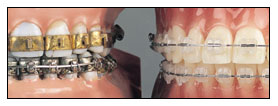March 23rd, 2017
 Wearing braces can feel like a major lifestyle adjustment. Suddenly you're faced with situations you never really thought of before. What happens when you indulge in the spinach dip appetizer at your favorite restaurant? How do you handle lunchtime at school, when you're away from the comfort and convenience of your bathroom at home? Fortunately, adapting to life with braces isn't as overwhelming as it may seem. With a little preparation and a few handy supplies, you'll be a braces-wearing pro in no time.
Wearing braces can feel like a major lifestyle adjustment. Suddenly you're faced with situations you never really thought of before. What happens when you indulge in the spinach dip appetizer at your favorite restaurant? How do you handle lunchtime at school, when you're away from the comfort and convenience of your bathroom at home? Fortunately, adapting to life with braces isn't as overwhelming as it may seem. With a little preparation and a few handy supplies, you'll be a braces-wearing pro in no time.
To help make your orthodontic experience as convenient as possible, we'll send you home with a on-the-go braces care kit filled with essential orthodontic items for keeping your braces clean and comfortable. We’ve also put together this list of helpful tips and additional dental items we recommend that will help you care for your braces while you’re at school or work.
Go Prepared
Remember to take your on-the-go braces care kit with you. It contains a toothbrush, floss, dental wax, interdental proxy brush and brushing timer. When you wear braces, it's much easier for food and bacteria to build up on the teeth throughout the day. Good oral hygiene is incredibly important to keep your smile looking as healthy as possible. You may also want to pack some toothpaste, floss threaders, a retainer case (if needed), and some OTC pain medicine. If your school nurse requires a permission form for over-the-counter medication use during the school day, our office will be happy to make that available to you.
Use Your Time Wisely
Take advantage of breaks and the lunch hour to give your braces and teeth a once over. Make sure you don’t have any food debris caught in your braces, and take the time to brush and floss. If you’ve just had your braces adjusted recently, you may feel some mild discomfort in your gums or cheeks. This is where the OTC medications and wax you packed will come in handy.
Eat the Right Food
You can prevent any possible mishaps or breakages with your braces by steering clear of foods that are sticky, chewy, and crunchy. Gum, candy, popcorn, hard chips, apples that aren’t cut into bite-sized pieces, nuts, beef jerky, and ice fall into this category. The last thing you want is to break a bracket in the middle of the day.
Choose a Removable Option
If you know before you begin orthodontic treatment that traditional braces will be a challenge due to employment and/or social situations, think about trying a removable option. For many adults with hectic schedules, clear Invisalign® aligners are convenient braces-free option. Clear aligners can be just as effective as braces for most teeth-straightening needs, and they can be removed while you’re eating, brushing, and flossing. They also tend to be more comfortable, since they don’t have metal brackets and wires to irritate your gums.
If you follow these tips and stay on your oral health routine at home, you’ll be maximizing the effectiveness of your orthodontic treatment but also keeping it as hassle-free as possible. For more information on caring for your braces while on the go, contact the team at Bel Air Orthodontics.
March 15th, 2017
 Even though your braces have been removed, your orthodontic treatment isn’t quite finished yet. Retainers must be worn routinely after treatment in order to hold your teeth in their proper, new position while your gums, ligaments, and bones adapt. You’ll be required to wear your retainer full time (twenty-four hours a day) for the first six months (except while eating and brushing your teeth), after which your wear time will typically be reduced to just at night while you sleep.
Even though your braces have been removed, your orthodontic treatment isn’t quite finished yet. Retainers must be worn routinely after treatment in order to hold your teeth in their proper, new position while your gums, ligaments, and bones adapt. You’ll be required to wear your retainer full time (twenty-four hours a day) for the first six months (except while eating and brushing your teeth), after which your wear time will typically be reduced to just at night while you sleep.
Why do I need retainers?
Your teeth will shift and become crooked again if you do not wear your retainers. Bone remodeling around the roots of your teeth allows the braces to move your teeth. Research demonstrates that remodeled bone requires up to six months to regain original strength. As the bone restores its strength, your retainers maintain your beautiful smile by holding the crowns of your teeth in their proper position.
Removable Retainers
The main advantage of removable retainers is their ease of use. You can take them out when you eat and when you brush and floss your teeth. Most importantly, removable retainers need to be used as directed to be effective. There are downsides to using a removable retainer, however. They can easily be forgotten at times; and if you are not wearing them as prescribed, they can't do their job of retaining your teeth. Even worse, because they are removable, they are easy to misplace.
Types of Removable Retainers
- Essix (Clear) Retainers: The Essix retainer is a clear, removable retainer that fits over the entire arch of your teeth. Similar to clear aligner trays, Essix retainers contain no metal or wires. They can also be used to produce minor tooth movements, and can be helpful in prevention of tooth wear due to tooth grinding at night.
- Hawley Retainers: The Hawley is one of the most common types of removable retainer. It consists of a combination of a metal wire that typically surrounds the six front teeth and an acrylic framing to hold it in place. The acrylic can also be personalized with a large selection of colors or patterns.
Permanent (Bonded) Retainers
Permanent retainers are placed onto the inside surface of your top and bottom front six teeth. They are made of small, thin brackets which are connected with a wire. Once your permanent retainers are placed in your mouth, you won’t need to worry about daily retainer schedules, since they are permanently affixed to your teeth. Because teeth start to shift naturally as we age, permanent retainers typically offer better long-term results for keeping your teeth straight than removable ones do. You can’t forget to put it in; it’s already there!
Retainers help to maintain your new, healthy smile; but they only work if you wear them as prescribed. You've worked hard for that great smile, so don't take any chances. Remember to keep your retention appointments and follow Dr. Godwin's instructions, and you can have a healthy smile that lasts a lifetime!
March 1st, 2017
Styles come and styles go. Skinny jeans and retro sunglasses made a comeback, so will we start seeing 1920's orthodontic hardware popping up in mouths from Maryland to Manhattan?

You decide.... At left is a set of full-banded braces, circa 1929, fashioned from metals including gold bands on the top teeth. At right is an example of modern braces featuring translucent brackets and the heat-activated nickel-titanium wires developed through NASA. We think you'll agree: Braces have come a long way!
Today braces have been embraced as a modern-day fashion statement and are considered "a cool thing to have" by the younger generation. And it's not just children and teenagers who are happy to wear braces - twenty-five percent of orthodontic patients are now adults who are choosing orthodontic treatment to improve their smiles. No wonder it's socially acceptable, with Hollywood stars like Tom Cruise, Faith Hill and Britney Spears strutting the red carpet with their dazzling braces-filled smiles. After all, who doesn't want to look like a movie star!
Studies show that a combination of factors have contributed to the current acceptance of orthodontic appliances. First, the technology has improved considerably over the past 20 years or more. Not only have traditional braces become more lightweight and discrete, but they have become more effective, leading to shorter treatment times with less discomfort. And of course there are now a range of less conspicuous methods of straightening teeth, from clear ceramic braces to virtually invisible options such as Invisalign®. Secondly, a greater awareness of the health importance of having good teeth has made people more open to orthodontic treatment. And last but not least, as more people are opting for orthodontic treatment the likelihood of being teased in the schoolyard for having braces has dramatically decreased. Today's youth agree that all the cool kids are doing it.
Chances are, your great-grandfather's braces won't make a comeback any time soon. If you'd like to learn more about today's orthodontic treatment options and which one is right of you or your child, contact us today to schedule a complimentary initial exam.
February 20th, 2017
 Today marks President's Day, a day known for celebrating of both George Washington's and Abraham Lincoln's combined birthdays. President's Day was created in 1971, when President Richard Nixon combined the birthdays of two of our most well-known presidents into one single federal holiday.
Today marks President's Day, a day known for celebrating of both George Washington's and Abraham Lincoln's combined birthdays. President's Day was created in 1971, when President Richard Nixon combined the birthdays of two of our most well-known presidents into one single federal holiday.
In honor of President's Day, we thought we'd share a few fun facts about our nation's presidents:
- Abraham Lincoln, our 16th president, carried letters, bills and notes in his tall stovepipe hat;
- George Washington is the first president to be featured on a postage stamp;
- Ronald Reagan, our 40th president, broke the so-called "20-year curse," in which every president elected in a year ending in zero died in office;
- Harry S. Truman was the first president to have his Inauguration and speeches televised;
- Abraham Lincoln was the tallest of the U.S. president measuring six foot, four inches tall;
- Virginia is the birthplace of more United States presidents than any other state, followed by Ohio and Massachusetts;
- There were four presidents born in February including George Washington, Abraham Lincoln, William Harrison and Ronald Reagan. Most celebrate President's Day in honor of the first two.
Share these fun facts with your family and friends!
 Wearing braces can feel like a major lifestyle adjustment. Suddenly you're faced with situations you never really thought of before. What happens when you indulge in the spinach dip appetizer at your favorite restaurant? How do you handle lunchtime at school, when you're away from the comfort and convenience of your bathroom at home? Fortunately, adapting to life with braces isn't as overwhelming as it may seem. With a little preparation and a few handy supplies, you'll be a braces-wearing pro in no time.
Wearing braces can feel like a major lifestyle adjustment. Suddenly you're faced with situations you never really thought of before. What happens when you indulge in the spinach dip appetizer at your favorite restaurant? How do you handle lunchtime at school, when you're away from the comfort and convenience of your bathroom at home? Fortunately, adapting to life with braces isn't as overwhelming as it may seem. With a little preparation and a few handy supplies, you'll be a braces-wearing pro in no time.


